Blog posts are written by project team members. Topics range from conferences we attend, musings on current affairs of relevance, internal project findings and news and more succinct content which can be found in our Digital Humanities Case studies or project related publications. Blog posts will mainly be posted in English but will from time to time feature in the language of the project team member’s preference, since we are a multilingual bunch! Happy reading!
Newspapers as „social“ media: Crowdsourcing and user-generated content in historical perspective
With the process of digitisation the entire media landscape changed fundamentally. One of the central innovations in journalism undoubtedly affects the understanding and the meaning of mass media. While formerly there were only few media and few senders with many recipients, in the digital age many people have the possibility to publicly distribute messages. Especially social media like Facebook, Instagram or Twitter have profoundly influenced the accessibility and the social relevance of journalists. With these platforms, there are now numerous ways to reach the audience, to exchange with them, to build a connection as well as to grasp and influence sentiments. On the contrary, in historical newspapers the linear distribution of content is usually in the focus of attention. Accordingly, the readers are seemingly largely passive consumers of news coverage. The digital media culture of the 21st century, however, is known for its interactive, dynamic communication between the editorial offices and the users, so that the boundaries between them are more and more blurring. The term “prosumer” (producer/consumer) and the omnipresence of participation and user-generated content emphasise this impression (Garde-Hansen 2011, p. 41–45). An analysis of historical newspapers from the backdrop of the interaction between newsroom and readership, however, highlights early phenomena of what we today call “social media”.
The reader strikes back
A major difference between former and today’s media culture is the fact that newspapers and other “publishing superpowers” (Pörksen 2018, p. 66) had the uncontested status in editorial decision-making. The public medial sphere was completely created by them, because they could decide what was published and what was not. Accordingly, they were the “gatekeepers” of the and had the monopoly in the discursive construction of the public sphere. From the 1990s and 2000s onwards the Web 2.0 led to a radical opening of this sphere and to the decline of the journalistic “superpowers”.
But also in historical newspapers readers had various possibilities to actively participate or even have content published. Especially striking are letters by readers to the editors. The historian Frank Bösch describes this as “controlled participation” (2005, p. 78), which underlines the aspect of the “gatekeepers”. With regard to the role of the readership and the development of media democracies in the 19th and 20th century this type of participation is of great interest, as a new “dimension of the public” is formed and people are enabled to participate in the creation of discourses (Leonhard et al 1999, p. 861). Certain searches in digital newspaper archives therefore offer to discover various phenomena.
So far in the discussion of the interaction between the newsroom and the audience the phrase “an unsere Leser” (“to our readers”) has been at the centre of attention (see here and here). They dealt with the questions of how the readership is addressed and what messages on the inside of the editorial office were communicated. The network from the corpus “an unsere Leser” (“to our readers”) with the visualisation “Links” shows up connections between the most frequently occurring terms, i.e. those that appear most frequently (blue) in combination with others (orange, figure 1), where the connection or proximity is the strongest.
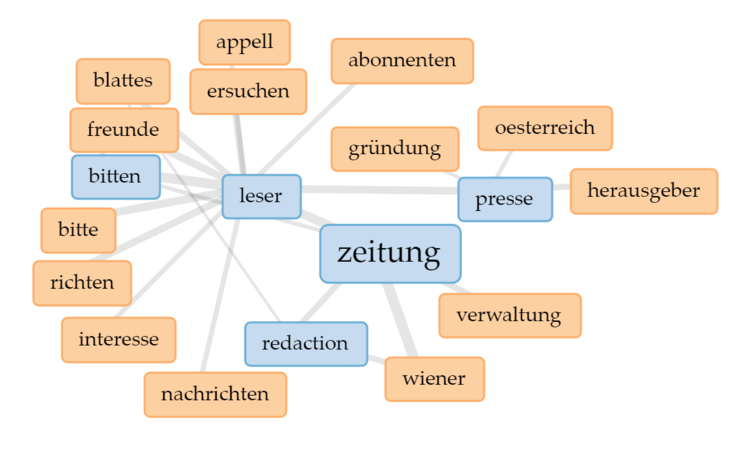
With regard to the keyword “leser” (“reader”) various networks can be identified. In particular, the keywords “appell” (“appeal”), “bitte” (“beg”/”please”) or “ersuchen” (“ask”) are highly relevant. The reference to certain appeals or requests underlines the interaction with the editorial office. Therefore it can be seen how papers attempted to integrate the audience and to motivate it to a specific action. The phrase “an unsere Leser” thereby provides first results, showing that above all requests to and from the newsroom were published, as Leonhard et al 1999, p. 869 explained.
Furthermore, those keywords that do not linguistically involve the readership, but the newsroom itself are worth looking into. The phrase “an unsere Leser” (“to our readers”), of course, only represents one part of the interaction. Word combinations such as “to the editors” (“an die Redaktion” and their results in ANNO are highly significant as they led to 35,690 hits. Other phrases, like “Leserbrief” (“letter to the editor”) (301 hits) or “Briefe der Leser” (“letters by the readers” (37 hits) were hardly efficient.
On the basis of the results from the corpus “an unsere Leser” the following phrases could be identified as recurring practices and rubrics: “Briefkasten der Redaktion” (“mailbox of the newsroom”) (11,602 hits), “Mitteilungen aus dem Publikum” (“messages from the audience”) (8,690 hits) or “Beschwerdebuch” (“book of complaints”) (4,229 hits).
It is worth pointing out the temporal distribution of the absolute frequency of the phrase “an die Redaktion” (“to the editors”) (figure 2).
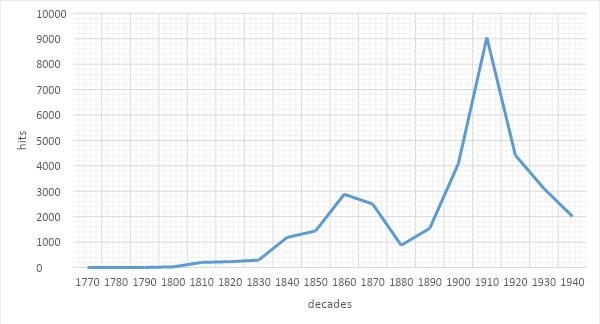
The huge increase from the 1890s onwards indicates that in this time the newsroom as the journalistic centre of production emerged. In the paper itself the editorial office became more visible insofar as it referred more often to the options for interaction and contact. In this sense it represented itself more as a recipient of information and messages and made itself accessible for external people and non-journalists. At the same time one may assume that the integration of the readership was requested more often.
Based on these results various forms of interaction and reader-involvement are assessable. Thereby journalistic practices can be described and the newspaper becomes a more interactive and dynamic apparatus of communication.
Crowdfunding and crowdsourcing: the newspaper as a social agent
The function of newspapers, as of media as a whole, is not only the objective and neutral distribution of information. Instead, as a distinct unity and institution, one medium always has a certain political ideology and agenda. As a consequence it can be seen as a specific political and social agent of its own. This idea manifests itself in appeals, requests and calls that were addressed to the audience. As is the case with digital media with a so-called “call to action”, such as the invitation to post comments under videos and images (Drotschmann 2019, p. 170), editorial offices in historical newspapers also tried to engage their readers. These instances often had a social background. In this sense historical newspapers also practiced crowdsourcing and crowdfunding, i.e. the collection of smaller contributions through a large number of people. They were usually financial contributions or donations, but also immaterial goods such as knowledge or information.
Concerning the financial dimension, the journal Der Obdachlose und Wohnungsuchende serves as a prime example. It was first published in December 1923 in Innsbruck in the publishing house of the club “Verein der Obdachlosen und Wohnungsuchenden” on a biweekly basis. On 1 September 1924 the paper directly addressed the readers in the note “An unsere Leser und Abonennten!” (“To our readres and subscribers!”) (figure 3). The note reminded the readers to pay for the journal in order to secure its survival. It allegedly was suffering from financial hardships. In addition, the memo indicated that the paper was not a profit-oriented, but a non-profit and voluntary business. The “crowdfunding” with the call for payment and support therefore provided an important means of financing. At the same time the reference to the economically difficult condition shows the lack of payments and the overall challenge of financing journalistic enterprises. In particular, socio-politically committed and non-profit newspapers severely suffered from this. The journal eventually only existed to the end of 1924.
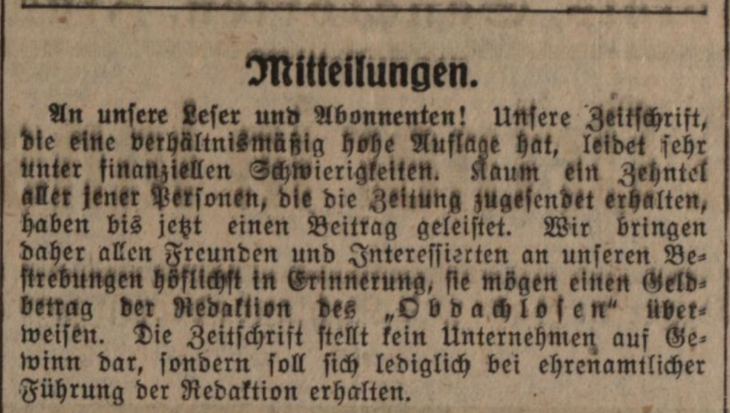
Another example for crowdfunding also has to do with the issue of homelessness. It is, however, not about a journal for excluded people and minorities, but about the fate of a homeless and jobless family. The Neue Freie Presse wrote in a short note on 5 January 1925 of an accountant who lost his home and is left to “the biggest misery”. The editors then requested the readership to help the man and his family find a job and to support them with donations. The administration knew his address.
Other similar examples of this newspaper occurred in the context of World War One or the burning of the palace of the judiciary in 1927. On the one hand, the paper asked the readers on 22 November 1914 to help refugees of war from Galicia with donations, in order to secure their existence. On the other it started a help initiative because of the over 80 casualties in the wake of the burning and violent riots on 15 July 1927. According to the appeal from 19 July 1927, the aim of the editors was to support the bereaved and the family members with financial contributions (figure 4). The publication of these stories emphasises the paper’s worldview and the agenda setting as a political and essential act of newspapers. With these initiatives the liberal Neue Freie Presse in no way appears as a neutral medium of news coverage, but as an engaged agent. The “call to action”, in particular the request to donate and support, is similar to forms of crowdfunding in contemporary digital media. This also holds true for content from the audience itself.
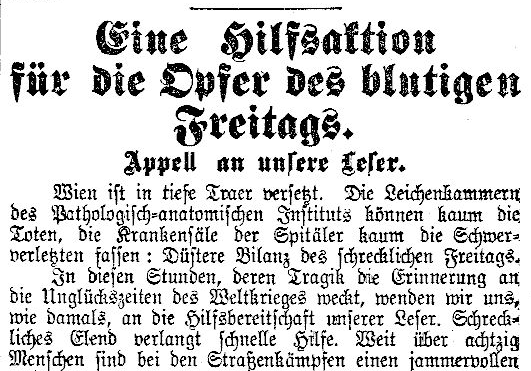
User-generated content: the newspaper as a forum and moderator
The opening of the public communication sphere in the present and the widely unregulated, free participation of the audience via social media has led to fake news and hate speech on the one hand and a more diverse range of opinions and a more open discourse on the other. User-generated content is generally a term for the participation of the audience and its contributions to the creation of media. In contrast to editorial content, user-generated content comes from outside the classic journalistic production. But also in historical newspapers and in the media culture of the “controlled participation” (Bösch) there were similar phenomena. Letters to the editors cover a large part of this. The newsroom as a whole was therefore in a constant exchange with the audience. The essential question, though, is whether these letters and their content were made visible in the newspaper itself. So the administration and moderation of these messages from the audience were vital.
Specific sections usually published letters to the editors. In this sense these were the editorial institutionalisation of the perspectives of the readership. For instance this occurred under the title “Mitteilungen aus dem Publikum” (“messages from the audience”) or in the “Beschwerdebuch” (“book of complaints”). The Neue Freie Presse opened the latter in autumn 1925 with the telling title “Eine Rubrik für alle” (“A section for everybody”) (figure 5). According to the note from 7 October 1925, the idea was to provide a “platform for discussion”. It would have been open for anyone who wanted to express “a certain complaint, a critique of the public affairs or a suggestion for its improvement”. The label “Rubrik für alle” (“section for everybody”) and its intention underline the function of the newspaper as a forum. The newsroom thus opened the communicative space for other perspectives and created an environment of multiperspectivity.
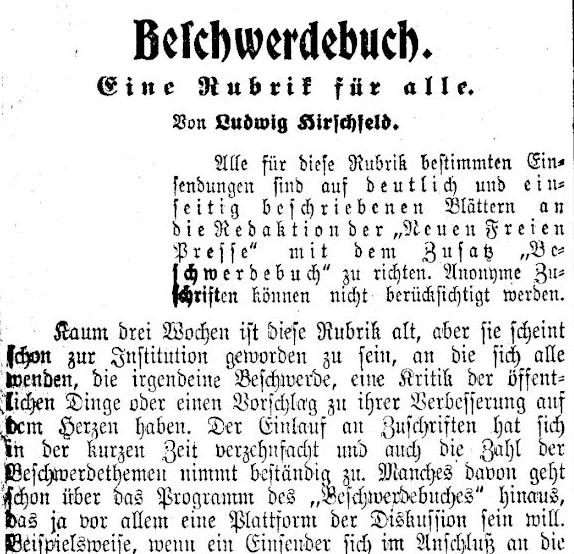
Furthermore, newspapers published explicit questions or surveys among the readership and invited it to send in letters, reports, impressions or opinions. During times of war, some papers asked their readers to provide field postcards with greetings from soldiers, which they later published. Thus, newspapers functioned as hubs of communication with the homeland front and the representation of the war itself. Examples for this are featured in the (Neuigkeits-)Welt-Blatt (24 November 1914, p. 9), the Illustrierte Kronen Zeitung (27 November 1914, p. 12) or the Innsbrucker Nachrichten (27 September 1939, p. 5). The Illustrierte Kronen Zeitung offered a special representation of user-generated content during World War One. Following a call the paper published previously sent-in “Kriegsküchenrezepte” (“war recipes”) over several weeks. For instance, together with the identification of the senders instructions of how to bake cakes or cook omelettes were featured on 12 February 1915.
Concerning the development of a democratic media practice the involvement of other perspectives is essential. These became especially visible in surveys, as an example from the Illustrierte Kronen Zeitung illustrates. As the question of where a certain memorial shall be placed, the paper asked for “advice” from its own readership. According to the article from 23 December 1928, the editorial office highly valued to “also hear the opinion of our readers”. Then it published numerous suggestions for a possible and meaningful site for the memorial. This example clearly shows how newspapers established a forum for other voices in the public discourse. The involvement of user-generated content, i.e. texts, comments or even pictures by the readership, indicates how historical media enabled a mutual debate of political or social affairs.
Conclusion
The interaction between the newsroom and the audience in newspapers from the 19th and early 20th century brings multiple forms of journalistic practices to the surface. Dealing with letters by the readers to the editors deconstructs the understanding of a merely linear and one-dimensional stream of information. Newspapers clearly were no neutral and objective sites of distribution. On the contrary: They were interactive, dynamic and indeed multi-perspective apparatuses of communication, which also were agents with a political and social agenda. Newspapers functioned as a forum for discussion. In this sense the degree of participation in one medium serves as an indicator of democratisation: the willingness to include and allow other opinions and to provide a platform for exchange and discussion. Of course, the possibilities of active participation cannot be compared to today’s digital platforms and the agency of users. Nevertheless it is evident that “new” media are not always radically innovative, but build on historical continuities. For that reason the role of the readership should never be underestimated nor neglected. Digital newspaper archives and the NewsEye project enable to investigate the past and to realise that history is far more complex than is often assumed in the present. The “shades of the former readership”, as Heinz-Dietrich Fischer acknowledged in 1972 (p. 23), are far more easily accessible with the digital tools than was the case up to now.
Newspaper resources
Der Obdachlose und Wohnungsuchende, 1.9.1924, S. 3.
Illustrierte Kronen Zeitung, 12.2.1915, S. 13.
Illustrierte Kronen Zeitung, 23.12.1928, S. 11.
Neue Freie Presse, 5.1.1925, S. 5.
Neue Freie Presse, 22.11.1914, S. 2.
References
Bösch, Frank (2005): Die Zeitungsredaktion, in: Alexa Geisthövel/Habbo Knoch (eds), Orte der Moderne. Erfahrungswelten des 19. und 20. Jahrhunderts, Frankfurt-New York, S. 71–80.
Drotschmann, Mirko (2019): “YouTube bietet ganz andere Möglichkeiten…” – Interview mit dem YouTuber Mirko Drotschmann (MrWissen2go), in: Christian Bunnenberg/Nils Steffen (Hrsg.), Geschichte auf YouTube. Neue Herausforderungen für Geschichtsvermittlung und historische Bildung, Berlin-Boston, S. 163–176.
Fischer, Heinz-Dietrich (1972): Publizistisch-Historische Beiträge, Band 2: Deutsche Zeitungen des 17. bis 20. Jahrhunderts, München.
Garde-Hansen, Joanne (2011): Media and memory (Media topics), Edinburgh.
Leonhard, Joachim-Felix/Ludwig, Hans-Werner/Schwarze, Dietrich/Straßner, Erich (eds.) (1999): Medienwissenschaft. Ein Handbuch zur Entwicklung der Medien und Kommunikationsformen (Handbücher zur Sprach- und Kommunikationswissenschaft/HSK 15.1), Berlin.
Pörksen, Bernhard (2018): Die große Gereiztheit. Wege aus der kollektiven Erregung, München.